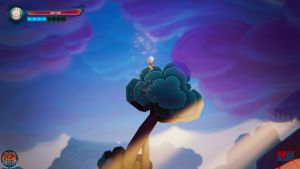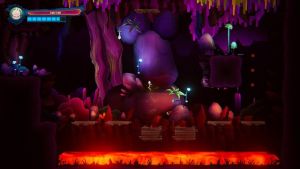Game Name: Red Goddess: Inner World
Platforms: PS4 (Reviewed), PC and XBox One (Oct. 2015), Wii U and PS Vita (Q1 2016)
Publisher: Yanim Studio
Developer: Yanim Studio
Release Date: June 30th
Price: $14.99
Update: This review was conducted on the updated code via the patch was was pushed out by Yanim Studios.
By the time I realized I had come to the final boss encounter of Red Goddess: Inner World, I let loose a sigh of relief. Not a good sign for a video 
Red Goddess: Inner World is an 8 – 10 hour Metroidvania adventure that follows the story of Divine, a young goddess among a pantheon who meet their untimely demise for mysterious reasons. The story begins with our protagonist awaking from a long slumber, having escaped the carnage and been drifting through space. She finds herself in the physical manifestation of her mind, her Inner World. By navigating through this plane, it is up to the player to collect her memories and solve the mystery of what happened while overcoming her inner demons (represented by the foes you encounter).
The narrative, while not riveting, is still somewhat engaging. It hits similar beats to that of Child of Light, dealing with both youth and grief. The art style is where Red Goddess works best. Its vibrant primary colors serve to illustrate the tone of the story, and its cartoon characters evoke classics like The Legend of Zelda and other titles that clearly inspired the game. The dialogue boxes and quirky, short murmurs from NPCs scream Nintendo.
Musically, there is not much to be impressed by. But the tunes serve their purpose tonally. Unfortunately, the entire game is followed by a narrator (tied to the plot by predictable twists), which can really become annoying when repeating difficult segments. I would have rather had the option to disable it.
While the game has charm, once the controller is in your hands and things get started the flaws start to become overwhelming. Red Goddess attempts to take the Metroidvania template, infuse it with old-school brawler elements, and throw in some good old platforming for good measure. The results are sloppy on all fronts.
The game advertises a non-linear map. However, unlike a game like Metroid Prime, where areas you’ll encounter five minutes in won’t open up for hours and will require lots of backtracking, Red Goddess will keep you on a fairly narrow path for the most part. While you can return to other areas, there is no real reason to. Unless you really want those character skins, that is.
Combat requires the player to switch between “rage” and “fear” modes, which really only amounts to red enemies take more damage from the former and blue the latter. Despite having options like fireballs and special charge attacks, at the end of the day mashing the attack button to punch and dodge is really what all the fights boil down to.
The issue is that enemies are color coded to the mode which hurts them most, meaning that if the player were to be in “rage” mode they would be a red character among a mob of red enemies, making everything very confusing to follow. On top of that, one hit will knock the player down for several seconds, meaning enemies can overrun you very quickly with literally no chance of escape, no matter how much one has upgraded their stats. Several fights I found myself unable to actually see where my character was without jumping and making myself vulnerable to projectile fire, which is also either red or blue. The only chance one has is to repeatedly dodge and hope to remain unscathed until a window opens long enough to punch a mob enough times.
Of all of the gameplay aspects, platforming is where Red Goddess becomes most frustrating. Unlike, say, Super Mario Bros., where the maps are perfectly balanced to the physics of the players movement, maps and puzzles in Red Goddess seem to have been designed without much thought given to how the player moves. For example, towards the end of the game there are long segments designed to force the player to use a hover ability in conjunction with aerial dashes to float through winding chasms lined with deadly spikes. However, the dimensions of the corridors and the spikes allow for no margin of error, and I found myself repeating segments over and over until I was lucky enough to just barley escape dashing into a wall of spikes.
The scarcity of checkpoints means that one mistake can result in repeating an entire section again and again. Furthermore, the powers of movement are tied to a finite mana pool that does not refill easily outside of combat or death. Thus, too much correction for any mistakes during platforming can leave one stranded in the middle of a puzzle without a way forward aside from suicide. As a Souls fan, I’m all for difficulty, but too many times this game feels luck based. It gets even worse when one realizes many of the time-based platforms, lasers, etc. are not in sync, which denies the player a chance to actually find a pattern.
As was said, Red Goddess can be pretty, and the simple style works really well for this game. But the game can chug, with entire backgrounds not loading because I moved too fast between panels. The technical issues extend into gameplay, leading to many forced reloads because I moved through a segment too quickly or did not align my character appropriately to trigger the next event. I even had to reload boss fights because I was mysteriously doing no damage. More QA testing would have gone a long way for this title.
It’s a shame, because Red Goddess really caught my eye and could have been a fun little title to help fill the summer void. It definitely has nice artistic work and concepts behind it. More work, however, should have been put into tightening the screws on the game behind it and making sure it played as well as the games it tries to emulate.
Great Ideas, Poor Game
While the concept and artwork could have made for an interesting title, the game itself becomes more frustrating than fun. The technical issues do not help, either.
Pros:
- Beautiful aesthetic
- Story
Cons:
- Platforming can be brutal
- Unrefined combat
- No reason to explore the map
- That narrator…
- Lots of technical hiccups
-
A Beautiful Yet Flawed 2D Side Scroller




